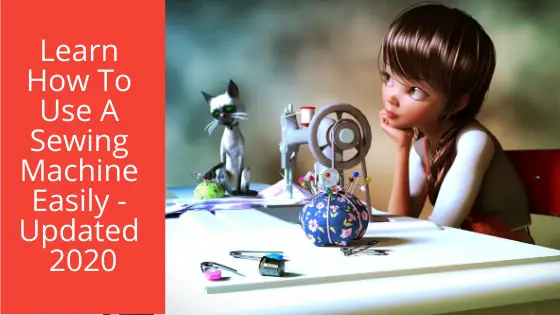Learn How To Use A Sewing Machine Easily – Updated 2020

If you were thinking about learning how to use a sewing machine, the time has come now. It is not that difficult to learn how to sew using a machine, but if you grasp the basic knowledge at the start, it will make a lot of difference in your journey to learn and use your new skill.
The Structure of a Sewing Machine
If you are wondering what are the essential steps in the beginning to start learning the sewing machine, we have the answer. It starts by learning the working of the machine itself.
It does not matter if you went out to a store and bought a shiny new one, or your old aunt Bettie gave you her old one, it is important for you to learn the fundamental language and working of your brand-new machine. It will help you in getting to know the machine before you start using it. Things will be much simpler and easier when you anticipate the majority of the surprises before.
As a novice, just starting out in the process of understanding the working of a sewing machine, you need to learn about all the bells and whistles inside the machine, from the power switch to the presser foot. Take some time to read the manual and check through each item before you start “sewing”. Look for simple yet basic points like your posture, direction of light, etc. It may seem obvious, but it will a lot of difference in your journey of how to sew clothes using a machine.
Parts of A Sewing Machine
I/O Switch: The most secure way to start learning a new machine is by getting to know the on/off switch. Usually, it is on the side of a machine where it can be reached easily from either side.
Bulb: There is a bulb in the needle area. Before start sewing, try it out. If you think the light is not enough, you can install a new light at your workstation or you can move the apparatus set up near the window where you can get all the natural light and enjoy the outdoor scenery.
Pedal: In a sense, the foot pedal that operates the sewing machine is your accelerator. Get a hold of the speed regulator so that things never get out of your hand and remain in the limit. There are some models that have a regulator switch near the pedal that allows you to go fast and slow with your sewing.
Stitches: You need to earn command over stitch length and width buttons which includes decorative stitches and zigzag. There are many cost-effective beginner model machines that will have preset stitches and lengths. However, more professional or expensive machines will let you set length and width independently such as buttonhole stitch settings.
There is so much basic stuff in this area that you need to master before you can start sewing. It is better to pay heed to the basics.
Tension Wheels: Generally, they are at the top or front of the machine. They play a key role in getting good symmetrical stitching without any loops.
Needle: There is a small screw attached to the needle that holds it in its place. In order to change the needle, you need to remember where the screw goes in.
Bobbin: It is, essentially, a lid that reveals bobbin case and the bobbin itself.
Bobbin Tension Screw: In the case of front-loading sewing machines, they are found on the bobbin case.
Oiling: If you want your machine to operate properly, you need to know where the oil marks are and make sure to get the right lubrication oil. Some newer models of sewing machines are sealed and don’t need oiling. So, before start squirting oil all over your machine, double-check the sealings for oil inlet.
Threading A Sewing Machine
There are many dimensions to how to use a sewing machine but the most common are the upper and lower ones. Now keep in mind: The upper threading and sewing machine tension are attached to the needle and the lower threading and tension are attached with the bobbin.
Read more about Using a Sewing Machine at https://5amily.com/quilting/blog/learn-how-to-use-a-sewing-machine-easily-updated-2020
